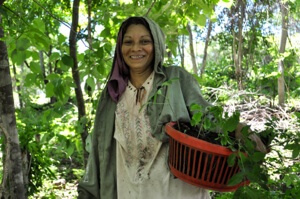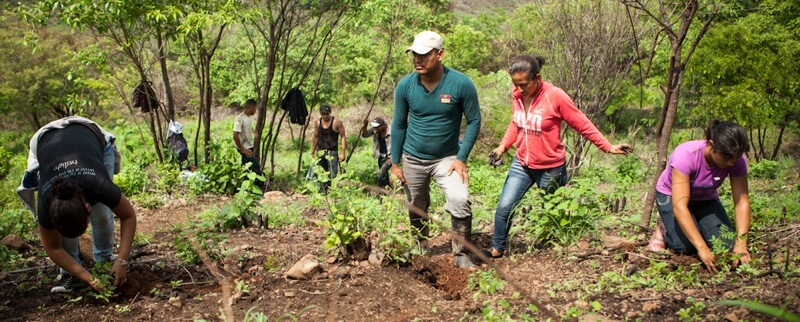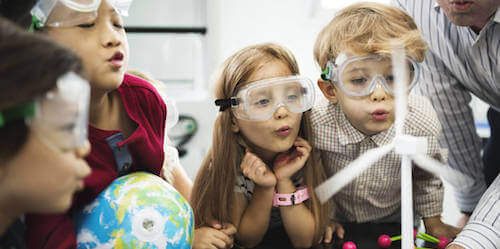 Social Reforestation - New forests for climate, nature, and humans
Social Reforestation - New forests for climate, nature, and humans
New trees in the fight against climate change and deforestation in Nicaragua
Maria Elisa Gonzales and her four children live primarily off self-produced food. In addition, they are able to earn a few dollars by selling some of their agricultural products. They use this money to buy clothes and other groceries, although, the return of their agriculture is shrinking because of erosion. Through this project, Maria Elisa Gonzales could already plant over 3,000 new trees. The first positive results can already be seen: the erosion is decreasing and the earnings from the cultivation of the trees provides the family with an additional income. This allows Maria to purchase food, clothes, and school material for her four children. "We hope that this good project continues to grow so that more small farmers can participate.
Necessity
Additional forests as a climate protection measure and as a means to support local smallholder farmers in Nicaragua
Activity
The local NGO supports tree nurseries and pays for the cultivation of the trees. Additionally, small farmers are trained in forestry and the building of wood-saving ovens.
Countable effort
Amount of seedlings that are bred for plantation
Result
Amount of CO₂ emissions (in tons) that are saved through the reforestation
Systemic effect
The project achieves a long term recovery of the ecosystem and an increase in revenue and quality of life for the local population. The quality of the air, the soil and the water regime are improved. The biodiversity is growing again.
Background
After Haiti, Nicaragua is the poorest country of Latin America: 42.5 percent of the population live in poverty (on two dollars or less a day), the illiteracy rate is at 7.5 percent (German Foreign Ministry, 2012). In rural regions, 70 percent live in poverty. Also, the region in which the forestation project is based is strongly marked by poverty. One of the most important causes for poverty and deforestation is the cotton cultivation. In the 1950’s, forests were extensively destroyed for the implementation of cotton farms. When the price for cotton deteriorated in the 1980’s, the region fell into poverty and was left in an economic and ecological disaster. Since then, the region is affected by erosion and the soils are poisoned by extensive use of pesticides. What is left behind is a devastated landscape with only few areas of intact nature left. New forests can restore the ecological balance and make the region habitable again. In addition, the new trees protect the existing agricultural surfaces from erosion and drought. The trees are a source of sustainable development. The Limay project is a forestation initiative that was developed in cooperation with the local community of San Juan de Limay in Esteli, Nicaragua. PrimaKlima is convinced that the support of the local population is crucial for the long-term cultivation of the forests. The project can only prosper when local families experience the advantages of reforestation. The local project partner, Taking Root, works in cooperation with small farmers to reforest unused surfaces. Through an improved use of land and sustainable forestry, the share of forests can be increased and the quality of life in the region can be strengthened. The goal of the project is to use reforestation as a tool to restore the ecosystem, to create sources of revenue, and to face climate change. Social reforestation represents a holistic sustainability: economy, ecology, and social prosperity are three equally strong pillars as the foundation of the project.
The good deed
Trees are planted on unused surfaces to generate additional income, create employment and increase agricultural productivity. Since forestry only provides long-term returns, a second concept has been introduced to bring a positive impact on the short and medium term. On the short term: interest free credits for small farmers, payments for ecological achievements, and the introduction of wood-saving ovens. On the medium term: production of firewood, and harvesting planted fruit trees. Long term: construction timber for subsistence, development of sustainable forestry with local tree species, selling wood and increased income.
Challenge
In the run-up to the project's implementation, a lot of explaining had to be done in order to convince the local population of the advantages of the project. This task has been carried out by the local partner, Taking Root.

AboutNicaragua
Managua
Capital
6.071.045
Number of inhabitants
1,840 USD
Gross domestic product per capita per year
129
Human Development Index
Nicaragua has great biodiversity. In the rainforest, live among others jaguars, pumas, ocelots, and various monkeys and reptiles such as alligators and snakes.
About the organization and further information
Association
PrimaKlima -weltweit- e.V.
DZI-Spendensiegel Initiative Transparente Zivilgesellschaft
Further information and source
- http://www.prima-klima-weltweit.de/
- https://www.baeume-verschenken.de/
- http://www.giz.de/de/weltweit/396.html
- http://www.conbio.org/images/content_publications/Chapter5.pdf
- http://www.auswaertiges-amt.de/DE/Laenderinformationen/00-SiHi/NicaraguaSicherheit.html
- http://de.wikipedia.org/wiki/Nicaragua
- http://gbgm-umc.org/NWO/01so/nicaragua.html
- http://www.ecologyandsociety.org/vol13/iss2/art24/
- http://www.bmub.bund.de/presse/pressemitteilungen/pm/artikel/aufruf-zum-wiederaufbau-von-150-millionen-hektar-an-waeldern/
- http://www.ipcc.ch/report/ar5/index.shtml
- http://unfccc.int/methods/lulucf/items/3060.php




